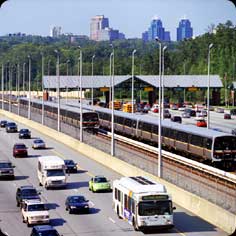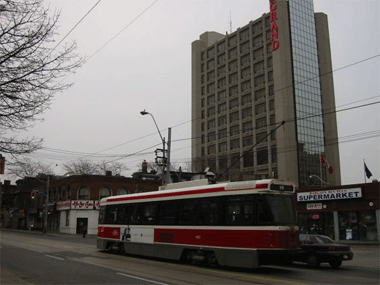
Urban Planning 538 - Economic Development Planning
Winter 2005
Contact Information:
Adam zettel
Last Modified:
April 19, 2005
 |
Urban Planning 538 - Economic Development Planning Winter 2005 |
Contact Information: Adam zettel |
Last Modified: April 19, 2005 |
With environmental and monetary costs of automobile transportation accruing, urban populations increasing, and cities attempting to reinvent their urban cores and polycentric business areas, it is no wonder that many municipalities and transit authorities are looking toward rail transport to accommodate current and future growth. Proponents of mass transport contend that such transportation reduces pollution via emissions and impervious surface reductions, eases auto congestion, saves users costly fixed and incremental driving costs, and assists the handicapped, elderly, and low-income groups with access to work and amenities. Advocates also argue that mass transportation in the form of rail can act as a catalyst to economic development. It is this last point that this discussion turns to.
The benefits of rail transport are often contested and difficult to discern. Proponents and dissidents regularly dispute the tangible and intangible impacts of rail transport. When posing the question of whether or not rail transport in an urban environment is cost effective and beneficial to economic development, the short answer is yes. However, closer inspection reveals the many pitfalls and nuances related to rail transport that can make or break an economic development agenda. The following shall illustrate how rail can function as an economic stimulant, what policies compliment rail transport, and what the experience has been for cities that have attempted to foster economic development with a rail network. Lastly, a summary shall synthesize the best practice for developing a general economic development plan contingent upon a rail network.
The theory that drives the use of transit as an economic development tool lies in transit's ability to provide higher densities and to create activity centers. Essentially, transit lines provide an alternative to the automobile, allowing more people in specified areas without increasing demand for roadways and parking. This allows more activity to occur in close proximity of a transit node such as a rail or subway station. Furthermore, an effective transit system not only allows for more housing, business, and recreation activity to occur at such locations, but it also encourages such dense development by providing a base of commuters and a common destination. Essentially, a transit center provides a scarce source of land that accomodates dense, mixed-use development.
As such, the provision of a scarce land commodity often leads to further development, which leads to densification that provides a vibrant economic and activity center. This, in turn, leads to even more market demand for such a location, and the cycle continues. This theory of development can often be played out in new and redeveloping urban areas if the actors in the development scheme successfully plan for such development.
Concerning the tangible effects of a transit network, experience indicates that transit lines and nodes create jobs, increase property values, and efficiently link labor and business (UWMCED 1992; NBCRT 2003). It is also felt that an efficient transit network provides an additional economic boost to impoverished communities by connecting immobile populations (those that do not have access to an auto) to job and activity centers.
Furthermore, it is contended that such nodes add a difficult-to-measure, yet greatly important vibrancy to the urban fabric. Even if a transit network is “not cost-effective when evaluated with a conventional analysis and current market conditions, substantial investment in a transit grid might pay off in the long run in ways not easily measurable now” (Moore 1994, 110). As observed in Toronto, Ontario, it is often felt that increasing activity in a city center may create a highly desirable urban culture that contributes to the economic vitality of a city.
“Adding new transportation capacity (either highway or transit) will have little effect on urban land use if all other policies are held constant” (Moore 1994, 41). Concerning policies, land-use and related transport decisions must compliment a new or existing rail network or no positive change is guaranteed to occur. Land-use polices must encourage higher densities around transit nodes and promote non-motorized forms of transport in adjacent areas (i.e. maximum parking requirements or transit orientated development TND). Essentially, just because transit accommodates higher densities does not mean that such densities shall occur. Land use regulation in the form of planning, zoning, and design standards must encourage high density, mixed use development to concentrate around transit nodes. Only by doing so can cities reap the benefits of increased economic activity.
Transport and land use polices must also compliment a rail network by encouraging ridership. This may mean restricting road widenings or expressway extensions in nearby areas. Other policies that contribute to the viability and long term effectiveness of a transit system may also include Urban Growth Boundaries and increasing parking and driving fees. Only if such policies are acted upon can a network sustain itself and create the positive economic development benefits that are sought.
A rail network that is not properly planned and accommodated by land-use and transport policy may not be cost effective or successful at delivering economic development. Atlanta provides an example of a transit network that has not lived up to its economic potential.
 |
| Photograph by Marta |
Despite the massive investment in MARTA (Metropolitan Atlanta Regional Transit Authority) in the 70s, Atlanta appears to be one the most threatened urban areas in the United States. Even with dramatic economic and absolute growth, Atlanta is still highly segregated, inequitable, and threatened by the costs of sprawl. City services, crime, black poverty, schools, and pollution are in crisis (Keating 2001, 208-210).
The reason that MARTA is not credited for economic growth in Atlanta City is because of the lack of planning and absence of complimentary land use policies. Essentially, the MARTA rail system was created to give Atlanta a “big city” transportation system, not to integrate disadvantaged populations with the sprawling economy, create higher density activity areas, or to provide an alternative to the auto. As such, the rail was placed in affluent, auto dominant areas where there were not any concentrated densities, activities, or efficient ridership around stations (Keating 2001, 113-114). Furthermore, when consultants recommended an ordinance that would drive high density development for station areas, governing bodies rejected their arguments in favor of a laissez-faire approach to land-use.
 |
| Photograph by Trail Canada www.trailcanada.com |
However, the Toronto model of transport is felt to be very successful at achieving both an efficient transit network and economic growth. Toronto has been touted as a North American urban anomaly: a city that works. It ranked fourth worldwide in a quality-of-life survey of 118 cities released in January, 1995 by a Swiss-based human resources consulting firm. Visitors are entranced by the prompt public transportation network consisting mainly of a subway, commuter rail, and a vast streetcar network (Holden 1995).
Due to the provision of complimentary policies, the city was able to attain the critical mass of density necessary to ensure adequate ridership numbers and densities that promote spiraling economic development. Planners generally believe that Toronto 's decisions regarding investment in transit have shaped much of the city's urban form, vibrancy, and economy ( Moore 1994).
Transit can play a valuable role in shaping and increasing the economic activity of a location. If land use policies encourage high density development around transit nodes, then a symbiotic relationship often develops that accumulates in the form of increasing populations, businesses, recreation, and general urban activity or vibrancy in such areas. Transit friendly policies such as limited parking, road tolls, and transit incentives also increase the impact that a transit network can have.
The key to success with a transit network is to plan out the corresponding land uses and transit nodes accordingly. A critical mass of commuters must be achieved to make high density areas and non-auto travel dominate. This is especially true for auto dominant areas that are investigating a new rail transit system (such as Phoenix's Valley Metro). Likewise, a minimum density is needed to make the financial feasibility of a transit network viable. As such, cities must plan carefully and consider what the long term benefits of transit are.
University of Wisconsin-Milwaukee Center for Economic Development:
American Public Transportation Association:
Holden, Alfred, “Why Toronto Works.” Planning March 1995 v61 n3 p4(7).
Keating, Larry. Atlanta: Race, Class, and Urban Expansion. Philadelphia: Temple University Press. 2001.
Kelbaugh, Douglas, Common Place. Seattle: University of Washington Press, 1999.
Levine, Mark. “Light Rail in Milwaukee : An Analysis of the Potential Impact on Economic Development.” May 1992. University of Wisconsin-Milwaukee Center for Economic Development web page, http://www.uwm.edu/Dept/CED/publications/lightrail.html, April 4, 2005
Moore, Terry and Paul Thorsnes. The Transportation/Land Use Connection. Chicago: American Planning Association, 1994.
(NBCRT) THE NATIONAL BUSINESS COALITION FOR RAPID TRANSIT. “The Economic Importance of Public Transit.” November 2003. American Public Transportation Association web page, http://www.apta.com/research/info/online/economic_importance.cfm , April 4, 2005